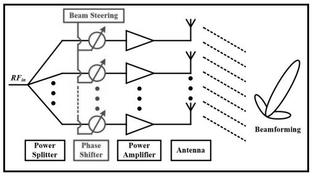Radar Antenna Beamwidth Calculator
Calculate the beamwidth of a radar antenna using this simple online tool, based on antenna diameter and radar frequency.
Showing 20 posts (Page 6 of 8)
Advertisement
Calculate the beamwidth of a radar antenna using this simple online tool, based on antenna diameter and radar frequency.
Understand radar cross range resolution: its definition, types (azimuth and elevation), calculation using the formula, and related terms.

Explore radar duplexers, their function in switching between transmission and reception, different types (branched, balanced, circulator), and their advantages/disadvantages.

Calculate the radio horizon distance based on antenna height using this handy online tool. Determine maximum communication range considering atmospheric effects.

Explore radio stripes: their definition, benefits, and drawbacks. Learn about their use in cell-free architectures and their impact on wireless communication.

Calculate the ideal radome thickness based on frequency and material properties. Learn about radome function and applications.

Calculate the rain absorption temperature based on rain absorption (dB) and physical antenna temperature. Useful for RF system design and analysis.

Explore common sources of satellite dish interference, including weather, terrestrial sources, and obstructions, and learn practical mitigation techniques.

Explore the differences between resonant and non-resonant antennas, focusing on radiation patterns and wave behavior.

Learn how an RF circulator works, its operational principles, and its applications in RF systems. Explore its use in sharing antennas between transmitters and receivers.

Explore RF energy harvesting systems: how they capture and convert ambient radio frequency signals into electrical power for low-power devices and IoT.

Explore the benefits and drawbacks of RF phase shifters, including applications, specifications, and impact on signal propagation in antenna systems.

Explore the pros and cons of rhombic antennas, including their simple design, stable impedance, space requirements, and power loss.
Explore the differences between SAIC and DAIC interference cancellation techniques in GSM networks, focusing on their impact on network capacity and performance.

Learn about SAIC (Single Antenna Interference Cancellation), a technique used in GSM DARP phones to improve receiver performance and reduce interference.
South African National Space Agency (SANSA) unveils a Ku band antenna for in-orbit satellite testing, enhancing its space operations facility and supporting satellite commissioning.
Explore various satellite antenna types, including parabolic, horn, phased array, and helical antennas. Learn their advantages, disadvantages, and typical applications.
Explore key terms in satellite communication, including antenna characteristics, power metrics like EIRP and G/T, amplifier operation (IPBO, OPBO), signal flux density, and polarization techniques for frequency reuse.

A satellite dish antenna receives satellite signals and directs them to a TV via a set-top box. Some dishes can also transmit signals.

Explore the fundamentals of satellite ground stations, including their architecture, receiving and transmitting processes, and key specifications.
Advertisement